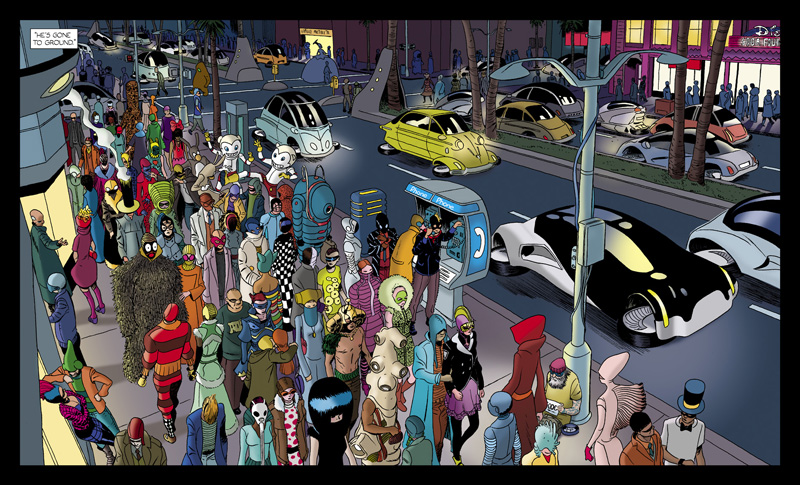I had a dream
David Bowie taught us how to skateboard
But he was shaped like Gumby
-Cyrus, “Twinkle Song”
There is something great about the image of tweens at a Miley Cyrus concert being forced into existential quandary by the pop star they grew up with now performing with a band of old dudes that dress in animal costumes and play psychedelic pop. I find hope in this image. I find hope in this fracture—a generation of wonderful freaks. Maybe it’s nostalgia for the effect that watching David Byrne—wearing a furry, pink suit –perform “Miss America” on The Late Show in the 1990s—would have on my own trajectory. How many of these moments can we count on our hands? How many of these moments have changed us?
Cyrus’s surprise, digital release Miley Cyrus & Her Dead Petz—largely a collaboration between Cyrus and The Flaming Lips (in particular the shaman, Wayne Coyne)—is an expansive, engaging, and tiring trek [site is no longer available]. Against her record label’s wishes, Cyrus self-produced and released Dead Petz online as a free streaming record. It is both sonically and conceptually tumultuous at times and likely difficult for many listeners as Cyrus delivers a wide-ranging set of mostly experiments in pop music written during her newfound freedom, however, it would be lazy to critique the record as soley “self-indulgent.” Cyrus, empowered by the success of her Bangerz (2013) record featuring the hit “We Can’t Stop,” decided to do something different with Dead Petz. Fighting gender bias, tabloids, media sensationalism, and the trope of the rise and fall of a debaucherous child-star, she produced a work so personal and off-the wall for a pop-star of her status, it will likely be remembered along with other seminal moments in popular music history.
The Beatles’s White Album (1968), another record that could be criticized as bloated, vain, and directionless, similarly found the band distancing themselves from their success post Sgt. Pepper’s Lonely Hearts Club Band (1967). The band traveled to India to study Transcendental Meditation, and, from time to time, worked on the songs that would later make the album. The resulting double-LP contains 30 songs, and features some of the most well known of the band’s oeuvre (e.g. “Blackbird,” “While My Guitar Gently Weeps,” and “Revolution”), but it is the “deep cuts” that best represent the Beatles’s ability to ride the line between a good hook and the weird. The result is challenging pop music that sounds just as fresh and exciting today as it did in ’68. Few songs surpass the amount of nuance and depth contained in a song as brief and complex as “Happiness Is A Warm Gun” (2:44), for example, or the gorgeous, “Sexy Sadie.” These are the songs that would truly make an impact on the form. Yet the greater point is that many of the songs from The White Album are pure fun, with arguably silly or ridiculous lyrics. The range of meaning is extreme and this is what makes it an especially unforgettable romp. And let us not forget that the Beatles are a former boy band.
Cyrus, along with the Flaming Lips who inject their psyche to the mix, ride the same line, though sometimes less consistently. The opening track “Dooo It!” in its first fifty seconds would seem to acknowledge an imminent disaster with its embarrassing lyrics: “Yeah I smoke pot, yeah I love peace/ But I don’t give a fuck, I ain’t no hippy/ Yeah I smoke pot, (do it) yeah I love peace (do it)/ But I don’t give a fuck (do it), I ain’t no hippy (ah).” But then, the chorus kicks in and suddenly the embarrassment is gone. Replacing the embarrassment is pure sincerity as Cyrus, accompanied by a dark melody and groove, croons: “feel like I am one with the universe/ and all I need is right here/ feel like I am part of the universe/ And it’s part of me.” Musically, there is plenty of Lips circa The Soft Bulletin (1999) and especially, Yoshimi Battles the Pink Robots (2002)—a Cyrus favorite—with some songs like “Karen Don’t Be Sad,” which teeters on the edge of plagiarism for some hardcore Lips fans. Despite this mimicry, Cyrus’s solid vocal performance once again claims ownership. A standout melancholy track, “Tiger Dreams,” features guest artist Ariel Pink and displays a darker and moodier Cyrus with foreboding “bells” and the refrain: “And we always end up singin’ the same song,”—which Dead Petz does its best to contest. Dead Petz is also filled with mournful moments as Cyrus laments the death of friends, her dog Floyd (“The Floyd Song (Sunrise)”), and fish (“Pablow the Blowfish”). Besides all the danceable doom, glam, and gloom, there are plenty of familiar beats, sex, and funk to go-around. “Space Boots” could easily be “We Can’t Stop” part II, while “Bang Me Box” is a sure hit for the electro-funk, Daft Punk-enjoying masses.
For all the talk of vanity-projects, The Flaming Lips, The Beatles, and guest stars, I would be remiss if I did not assert that this is completely a Miley Cyrus record. While the focus in the media has been on the “weird,” Dead Petz has a large collection of strong hooks, cracks, zings, beats, and melodies whose catchiness should cause no confusion. Surprisingly, not enough has been written praising Cyrus’s performance. For all the ups and downs that come with a transitional, experimental work like this, the one constant is Cyrus’s unshakable vocal delivery—here reaching new range and expression. For those that love to see falling child-stars, there’s none of that here. Instead, we are presented with a work that promises new life and adventure for the young pop star whose turn toward glam, psychedelic performance, and self-referentiality may offer hope for the many freaks mourning the passing of Bowie.



